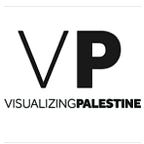Visualizing Palestine’s Philosophy on Updating Visuals
We have updated and re-released two of Visualizing Palestine’s widely used visuals to reflect more recent data and statistics. New versions of Gaza Water Confined and Contaminated (published 2012) and A Guide to Administrative Detention (published 2013) are now available to download from our website. Read on for:
- A summary of significant changes to these visuals
- Reflections on the VP team’s philosophy around updating visuals
Changes to Gaza Water Confined and Contaminated
- The percentage of water in Gaza’s coastal aquifer that is unfit for human consumption has risen from 95% to 97%
- The original visual referred to the 2008–2009 Israeli bombardment of Gaza and the damage it caused to essential water, sanitation, and hygiene (WASH) infrastructure. We have edited it to reflect that subsequent attacks have caused even more damage.
- A new source link has been added to the footer with all updated sources.
Changes to Guide to Administrative Detention
- Statistics dated to 2012 and 2013 have been updated to more recent figures or restructured to general (rather than time-bound) factual statements.
- Under “Can I see my family?”, we updated the text to emphasize that Israel’s practice of transferring Palestinian political prisoners from the occupied territories to prisons inside Israel is illegal under international law, and poses a major barrier to family visitation rights.
- Under “What if I’m pregnant?”, the text now emphasizes systemic issues of medical neglect in Israeli prisons.
- A new source link has been added to the footer with all updated sources.
VP’s Philosophy on Updating Visuals
With these re-releases, we have the opportunity to share our philosophy around updating VP visuals. Some of our practices include:
We update individual facts or statistics on a visual only when we have the capacity to review the entire visual, in English and in Arabic, to ensure that all information is valid as of the latest revision date. As a result, changes that seem quick and simple may require more in-depth review than most viewers realize.
Instantaneous updates are not always necessary for resources to remain relevant over time. This is because many of our visuals conceptualize structures and systems of oppression, which often remain constant even as detailed stats and figures fluctuate.
With that being said, members of our community sometimes request updates to specific visuals. We strive to meet these requests when we can, so that our collection of resources remains as relevant and useful to you as possible.
Every visual requires a different process to update. Some can be updated with text changes only, while others require significant visual changes and specialized design work by a specific contributor. Some updates entail extensive research, while others do not. These factors can influence which visuals we choose to re-release and how quickly we can act on update requests.
Some visuals are designed to capture a moment in time. When we create a resource for a specific moment, we sometimes want to keep it linked to that moment. These visuals make the most impact as a record of different phases of the Palestinian struggle for freedom.
When we do make updates, we strive to maintain the integrity of the original visual. We keep our changes as minimal as we can. If we desire more drastic changes, we may opt to design a new visual from scratch rather than updating an old visual.
Our work is published in English and Arabic. Any updates made to English versions will also be reflected in the Arabic versions. For the above updates, Arabic updates are in progress.
Some of our visuals are translated to other languages (beyond English and Arabic) by volunteers. Updating these translations is a more difficult process, so versions beyond Arabic and English may not feature the most recent information. We always welcome volunteer support with translation.
